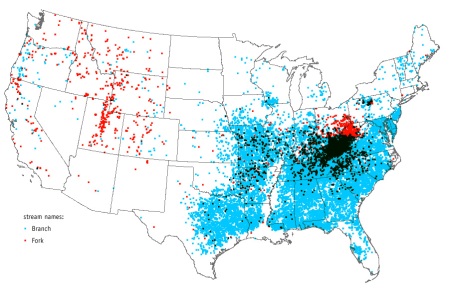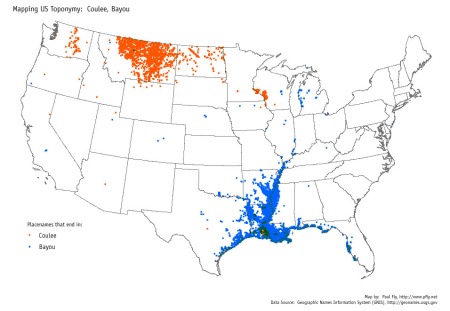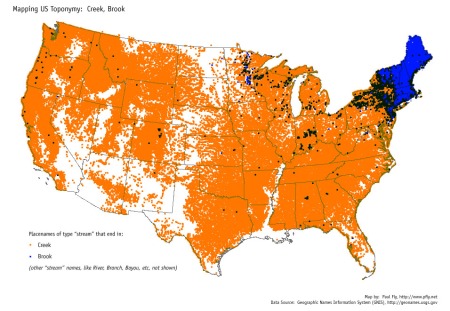Following up on my previous post about the geographic distribution of creek and brook place names in the US, here are a few other maps I made, looking for interesting regional patterns.
First a few more stream-related maps.

This map shows streams whose names end with “branch” and “run”. Branch is a common term throughout the South. Run coincides with the North Midland dialect area, as George R. Stewart puts it. It is a common term in the Appalachian Mountains of Pennsylvania and northern West Virginia. In southern West Virginia the term “branch” is generally used instead of “run”. There are some small areas where “run” place names are particularly dense, especially in north-west and north-central Pennsylvania and northern West Virginia. My map doesn’t show these smaller patterns very well because my dots are large enough to merge into a mass of red. Stewart explains that in colonial times, when these patterns emerged, “run” became a common term for the smallest of streams, while “creek” was used for larger ones and “river” for the largest.
This map shows streams whose names end with “run” and “slough”. The distribution of “run” streams is clearer than in the previous map. I’m not sure whether there is much of a pattern with “slough” and don’t know much about the term, its origin and history.
This map is like the others, but showing streams whose name ends in “branch” or “fork”. There’s a curious concentration of streams named “fork” in the Appalachians of West Virginia and Kentucky. Usage is scattered elsewhere with smaller concentrations in the West, especially in Utah.
One more map about streams. This one showing those whose names end with “coulee” and “bayou”. Unlike the others, this map isn’t restricted to just streams, because “coulee” is a term used for dry canyons as well as streams. Most of the bayous shown are probably streams or inlets of the sea. As expected, the term occurs almost exclusively in the lower Mississippi River region and along the Gulf coast. The usage of “coulee” has an interesting regional pattern. There are four distinct areas where the word is used, and it means slightly different things in each case. The first area is in Lousiana, and is hard to see on this map because it overlaps with “bayou” so much. It is used there for small streams. A friend of mine who lives in southwest Louisiana says a coulee is a stream narrow enough to step or jump across. A second area of usage is found along the upper Mississippi River in Wisconsin and Minnesota. Here the word is used for small, short, steep streams. A third area is found in the northern Great Plains of Montana and North Dakota (extending into Canada as well). Here the word is “the equivalent of creek”, according to Stewart. Finally, in Washington “coulee” is used to refer to region’s unusual dry canyons carved from basalt, such as Grand Coulee and Moses Coulee.
I have a few more maps to write about, but will save that for next time.



